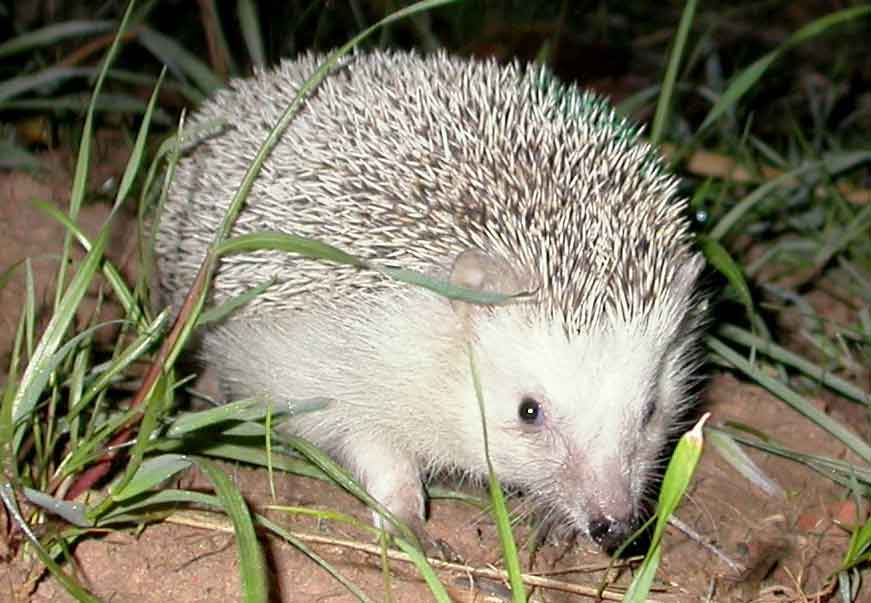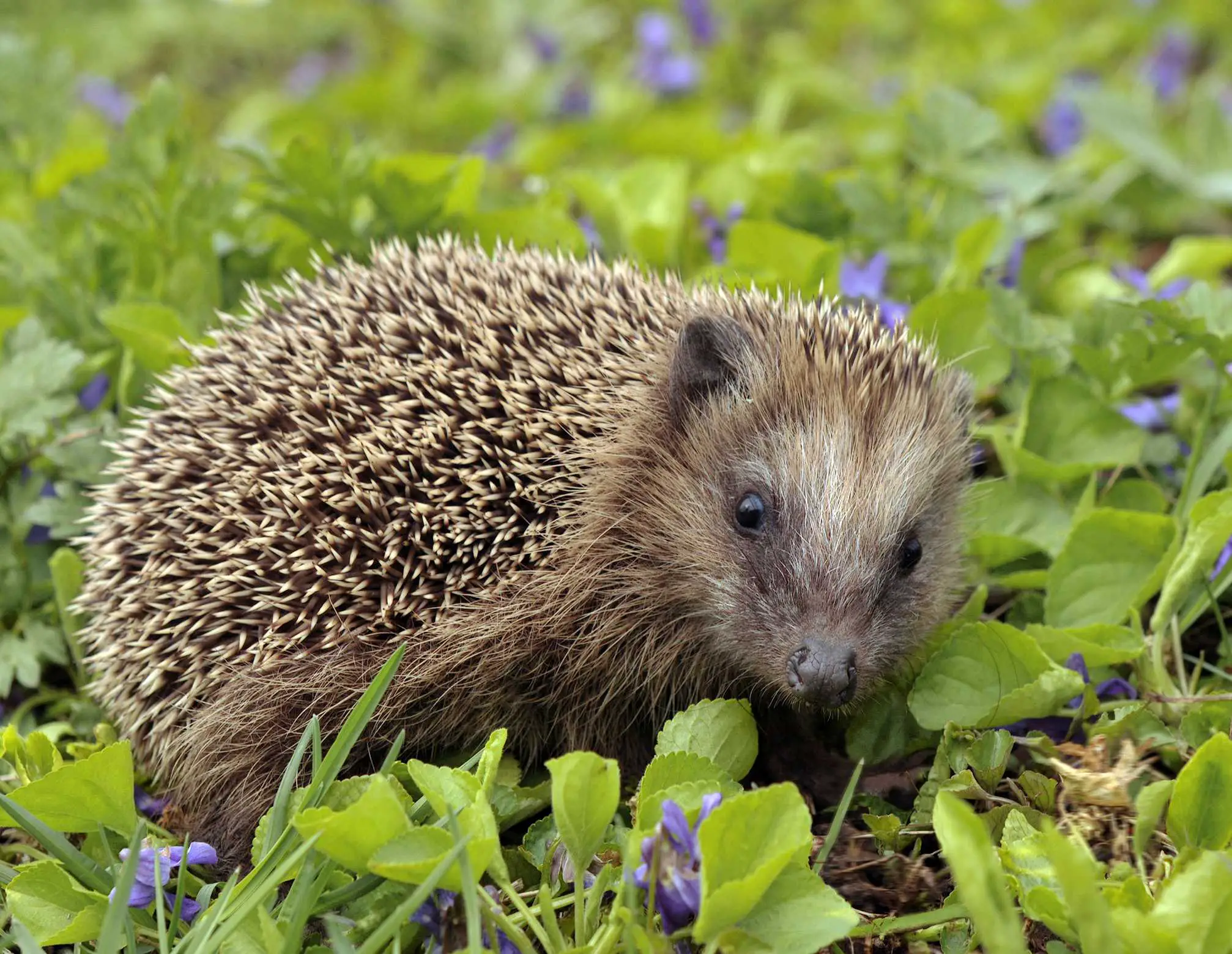The North African hedgehog, scientifically known as Atelerix algirus or the Algerian hedgehog, belongs to the Erinaceidae family and is indigenous to regions including Algeria, Libya, Malta, Morocco, Spain, and Tunisia. Unlike their European counterparts, these hedgehogs exhibit a distinctive paler hue in their coloration. Their physical dimensions typically span from 200 to 250 mm, distinguishing them from other species within the family. Notably, a distinguishing feature of the North African hedgehog is the absence of spines on the crown of their head, reminiscent of a widow’s peak. This unique characteristic sets them apart from related species and aids in their identification.
Physical Characteristics and Habitat
North African hedgehogs, characterized by their smaller size compared to other hedgehog species, possess a fascinating array of physical traits. Their paler coloration serves as a camouflage in their natural habitats, which encompass a diverse range of environments from arid regions to scrublands. Despite their diminutive size, they exhibit remarkable adaptability to various climates and terrains, showcasing the resilience of this intriguing mammalian species.
Diet and Foraging Behavior
The diet of the North African hedgehog is as diverse as the landscapes they inhabit. These omnivorous creatures primarily feed on a variety of insects, supplemented by fruits, seeds, and occasionally small vertebrates. Their foraging behavior is marked by a keen sense of smell and hearing, allowing them to locate prey efficiently even in the dark of night. This adaptability in diet and foraging strategies underscores their role as opportunistic feeders within their ecosystems.
Distribution and Habitat of the North African Hedgehog
Limited Habitat Knowledge: Despite its widespread presence, the precise habitat preferences of the North African hedgehog remain shrouded in mystery, with scant information available regarding its favored environments.
Known Habitats: This elusive creature has been sporadically documented in Mediterranean coniferous and mixed forest habitats, akin to those found in the mountainous regions of southern Spain and northern Africa.
Geographical Range: Across its range, spanning from Morocco to Libya in northern Africa, the North African hedgehog demonstrates a preference for regions characterized by moderate climates. However, it notably avoids arid desert landscapes prevalent in these areas.
Global Distribution: Beyond the African continent, sightings of the North African hedgehog extend to warmer regions, including certain parts of France, the Canary Islands, and the Balearic Islands, highlighting its adaptable nature and ability to thrive in diverse environments.
Urban Adaptability: Within its habitat range, the North African hedgehog exhibits remarkable adaptability to human-modified landscapes, often frequenting gardens and parklands, where it can find suitable shelter and forage for food amidst urban developments.
Reproduction and Lifecycle
The reproductive cycle of the North African hedgehog is a fascinating aspect of their biology. Typically, mating occurs during the spring months, with females giving birth to litters of young after a gestation period of approximately four to six weeks. The offspring, known as hoglets, are born blind and hairless, relying entirely on their mother for warmth and nourishment. As they mature, they gradually develop the characteristic spines that define hedgehogs, eventually reaching adulthood and contributing to the perpetuation of their species.
North African hedgehogs are native to the northern areas of Africa from Morocco to Libya. They have additionally been launched to close-by areas, together with the southern, mountainous areas of Spain, France, and the islands off the coast of Africa, such as the Canary Islands and the Balearics. Introduced populations in France are extinct.
North African Hedgehog Habitat
North African hedgehogs want arid climates, however are present in a broad range of habitats together with dry Mediterranean scrub, grasslands, pastures, cultivated fields, semi-desert, and gardens.
They are additionally discovered close to human populations. They are sometimes discovered at altitudes of 400 m or much less, though elevations of as much as 900 m have been noticed in Morocco.
Description of the North African Hedgehog
Resemblance to European Hedgehog: At first glance, the North African hedgehog closely mirrors its European counterpart, yet subtle discrepancies set them apart, delineating unique traits specific to each species.
Size Disparities: The North African hedgehog, while akin in appearance, typically exhibits smaller dimensions compared to its European counterpart. Measurements ranging between 20 to 25 centimeters in length and a weight of up to 650 grams characterize this diminutive yet resilient creature.
Distinctive Physical Features: Noteworthy attributes include its elongated snout, longer limbs, and prominent ears, which distinguish it from its African hedgehog counterparts. These adaptations contribute to its agility and swiftness, enabling it to navigate its habitat with adeptness.
Coloration and Markings: Sporting a predominantly brown hue on its head and limbs, the North African hedgehog presents a contrasting light-colored face, often white in appearance. The underbelly showcases variable tones, oscillating between shades of brown and white, adding to its visual allure.
Spines and Markings: A defining feature lies in its coat of smooth spines, predominantly white with darker banding, lending it a distinctive appearance. Notably, the absence of spines atop its head sets it apart from its hedgehog relatives, a trait known as the “widow’s peak.”
Ecological Interactions: Inhabiting regions prone to parasitic infestation, the North African hedgehog commonly hosts the hedgehog flea, Archaeopsylla erinacei maura, illustrating its interconnectedness within its ecological niche.
Distribution and Human Influence
Among the four African hedgehog species, the North African hedgehog stands out as the only one known to occur beyond the continent of Africa. Some theories suggest human-mediated introduction to regions like France, Spain, and the Canary Islands. Despite its wide habitat range and seemingly stable populations, both wild and domesticated, the species currently does not appear to be at risk.
Aestivation in Response to Desert Conditions
In the scorching temperatures of the desert, hedgehogs employ a survival strategy known as aestivation. Similar to hibernation but occurring during the summer months, aestivation involves the hedgehog retreating into hiding, reducing its metabolic rate, and relying on stored fat reserves until conditions improve. While akin to hibernation, aestivation differs in the depth and duration of sleep, allowing the hedgehog to conserve energy during extreme heat.
Conservation Status and Threats
Despite their widespread distribution across North Africa and parts of Europe, North African hedgehogs face various threats to their survival. Habitat loss due to urbanization, agricultural expansion, and climate change poses significant challenges to their populations. Additionally, they are vulnerable to predation by larger carnivores and are often victims of road accidents. Conservation efforts aimed at preserving their natural habitats and mitigating human-induced threats are crucial for ensuring the continued existence of these captivating mammals.
Other Recommended Articles
- Spotted-Necked Otter – Profile | Traits | Facts | Baby | Behavior
- Sea Otter – Profile | Traits | Facts | Eating | Legs | Baby | Cute
- Giant Otter – Profile | Traits | Facts | Size | Animal | Shrew
- South Asian River Dolphin – Profile | Traits | Facts | Skull | Eyes
- Hairy-Nosed Otter – Profile | Traits | Facts | Habitat | Behavior
- African Striped Weasel – Profile | Traits | Facts | Diet | Behavior
- Hog Badger – Animal | Profile | Traits | Facts | Skull | Baby | Wolverine
- Sunda Stink Badger – Profile | Traits | Facts | Behavior | Diet
- Chinese Ferret-Badger – Profile | Traits | Facts | Pet | Threats
- Common Genet – Animal | Profile | Traits | Facts | Pet | Diet | baby
- Honey Badger – Animal | Profile | Traits | Facts | Attack
- American Badger – Profile | Traits | Facts | Skull | Habitat | Angry
- Eurasian Badger – European Badger Profile | Traits | Facts
- Fennec Fox – Baby | Pet | Profile | Traits | Facts | Size
- Red Fox – Profile | Traits | Facts | Eyes | Color | Denning | Diet
- Martes zibellina – Sable – Profile | Traits | Facts | Pet | Description
- Polar Bear – Facts | Profile | Traits | Cub | Cute | Size | Height
- European Mink – Habitat | Profile | Traits | Facts | Skull | Teeth
- Arctic Wolf – Profile | Traits | Facts | Weight | Skin | Baby | Eyes
- Lemmini Lemming – Profile | Traits | Facts | Animal | In Snow | Picture

